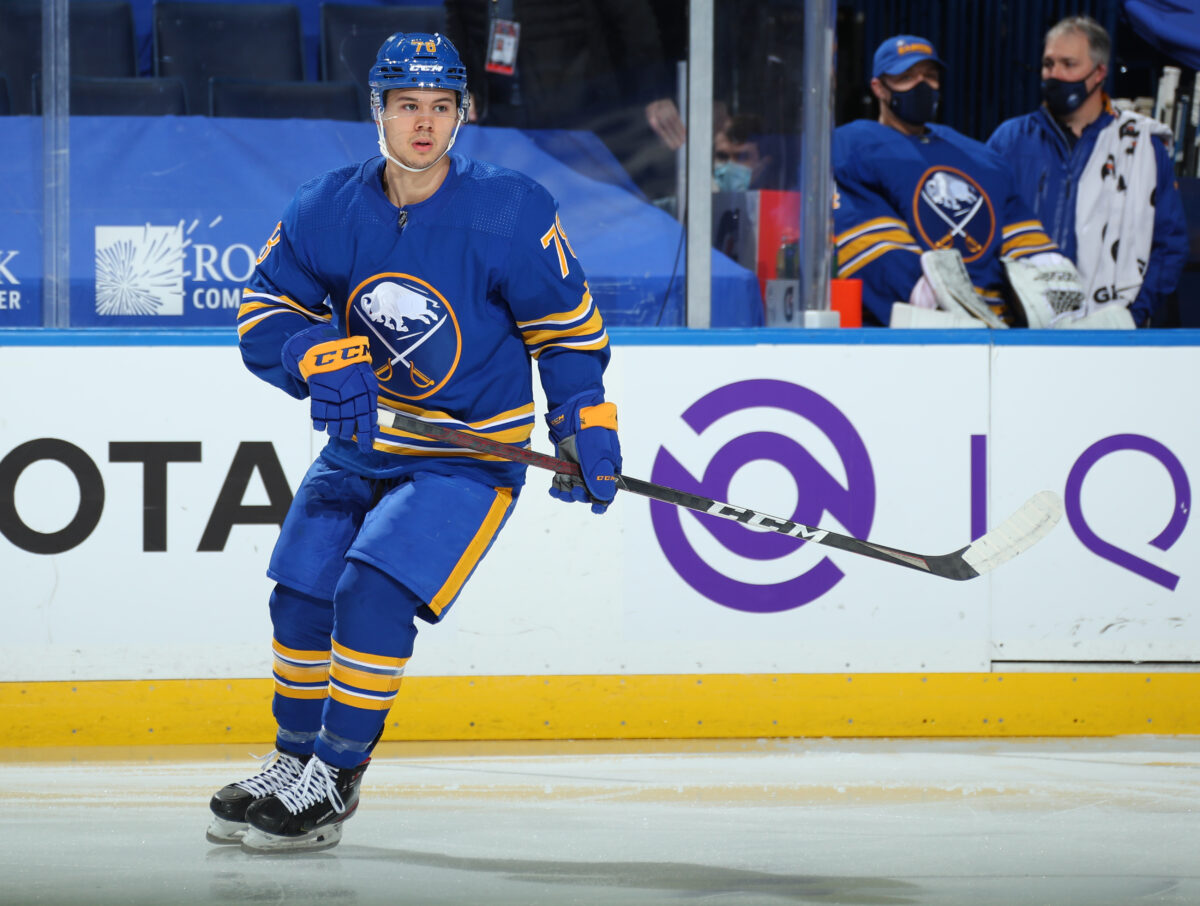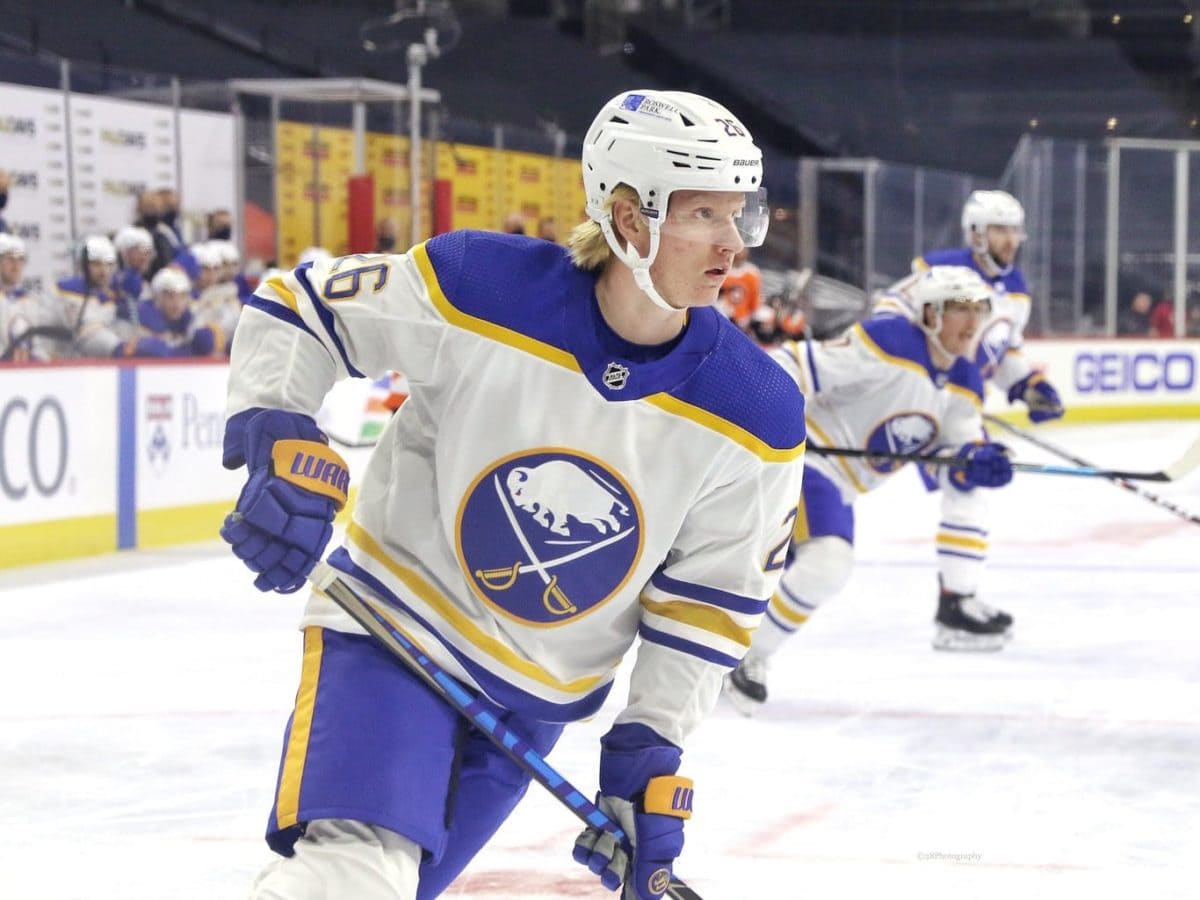It can be hard to find positives when you’ve spent the entire season in the league basement. The Buffalo Sabres’ 2-0 loss to the Boston Bruins on Tuesday dropped their record to 12-27-7 (31 points), keeping them in the number 31 spot in the overall standings that they’ve seemingly occupied since the 2020-21 season began.
But things aren’t quite as bleak in Buffalo as they looked even a month ago. After losing their first six games under interim head coach Don Granato, the Sabres have gone 6-4-2 in their last 12 games, including impressive wins over the playoff-bound Washington Capitals (5-2 on April 15) and Pittsburgh Penguins (4-2 on April 18).
Despite the absence, due to injury or trade, of big names like Jack Eichel, Jake McCabe, Taylor Hall, and Linus Ullmark, the Sabres are no longer an easy two points for opposing teams. The main catalyst for this recent stretch of good play has been the emergence of the team’s young core.
Late-Season Youth Movement
The Sabres entered the 2020-21 season with a good mix of youth and experience. But with the massive amount of roster turnover over the course of the campaign, the team has been forced in recent weeks to rely heavily on players with very little experience.
Take Tuesday’s game against Boston, for example. The average age of the 19 players who saw the ice against the Bruins was just 24.4. In fact, the only one over the age of 30 was goalie Dustin Tokarski (31).

But rather than holding the team back, these youngsters have injected life into a season that was dead on arrival just a few weeks ago. While every player would rather be in the midst of a playoff hunt, the lack of pressure has provided a sense of freedom to the players (not to mention not having to play in former coach Ralph Krueger’s rigid defensive system).
The Sabres’ collection of under-25 talent is a diverse one. There are former elite prospects like Rasmus Dahlin, Dylan Cozens, and Casey Mittelstadt. There are guys on their second teams looking for fresh starts like Tage Thompson, Henri Jokiharju, and Anders Bjork. There are wild cards that fans are seeing for the first time, like Jacob Bryson, Arttu Ruotsalainen, and Mattias Samuelsson.
All of them have brought something to the table in making the Sabres more competitive.
Finding New Life Under a New Coach
Nobody on the Sabres was having a good season under Krueger, but what was most concerning was how poorly the young players were performing.
Dahlin and Jokiharju looked lost on the blue line, trapped in a system that stifled their playmaking talent. Thompson and Mittelstadt were looking like busts who, like everyone else on the team, couldn’t find the back of the net to save their lives.

But things have changed drastically under Granato. Take a look at the combined numbers of those four players under the two coaches this season. Under Krueger: 73 games played: 4 goals, 16 assists, 20 points, minus-44. Under Granato: 68 games played: 17 goals, 15 assists, 32 points, plus-0.
The difference is night and day. And while that’s likely true of pretty much every player in the lineup, the fact that some of the names that management hopes will be a part of the rebuild are making steps in the right direction has to be a good sign. It also doesn’t hurt Granato’s case for being made the head coach of the future that so many young players are thriving under his leadership.
Future Core Starting to Take Shape
One key reason why the Sabres’ playoff drought is now in its 10th year is that the franchise hasn’t had a coherent plan. Too often, the lineup is a Frankenstein’s monster assembled of pieces brought in from two or even three different front offices, with no unified concept or team identity.
That’s the job that general manager Kevyn Adams and new associate GM Jason Karmanos have ahead of them. The good news is that they already have a bit of a blueprint for what next season’s team could look like. Here’s a glimpse at a potential Buffalo top nine for 2021-22:
- Jeff Skinner – Jack Eichel – Sam Reinhart
- Rasmus Asplund – Casey Mittelstadt – Tage Thompson
- Arttu Ruotsalainen – Dylan Cozens – Victor Olofsson
That might not remind anyone of the Detroit Red Wings circa 1997, but there’s a lot to work with, and that’s before even considering any offseason moves or the addition of a likely top-three draft pick. The most promising thing about this possibility is the depth at center. The Sabres have been looking for quality depth down the middle for a decade. They already have a superstar 1C in Eichel. If Mittelstadt and Cozens continue on their upward trajectories, Buffalo could actually have three reliable options at center for once.
On the back end, Rasmus Ristolainen, Dahlin, Bryson, Jokiharju, Samuelsson, and Will Borgen all figure to be factors in the rotation. Adams would be wise to add some pieces to the blue line as well.
Goaltending, meanwhile, remains a big question mark. Adams has made it clear that he’s interested in bringing back Ullmark, who’s a pending unrestricted free agent. He has proven that he can win games on his own, but his injury concerns have only gotten more glaring. This season also showed how badly Buffalo needs to improve its organizational depth in net.
The Sabres are looking at another rebuild right in the face, and this could prove to be the most daunting one yet. But Adams and company won’t have to rebuild from scratch. There is a foundation to build on here, and it starts with a young core that is growing more impressive by the day.